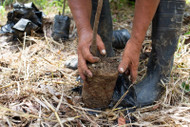The Secret Beneath Ecuador’s Legendary Cacao
Jun 5th 2025
It is the floral fruitiness and nutty overtones of Ecuadorian cacao that mind it one of the favorites of chocolatiers across the world. But what is so special about it?
It is all found under the skin-not in the rest of this nutrient-rich, volcanic soil but in ecological conditions that are just right for all. Such measures, along with cautious postharvest processing and sustainable farming best practices, both helped create exceptional quality cacao with wonderful flavour and depth.
Soil of volcanic origin is a sound foundation to plant cacao.
That is how the Ecuadorian landscape has been forged over a period of thousands of years-continuously worked on by volcanic activity-making it a sponge of really fertile soil-from which critical minerals become available nourished to cacao trees. These natural deposits help strong root development, improve availability of nutrient and support resilience of the tree-all giving place to producing high-quality cacao.
How do Minerals Key to Ecuadorian Cacao Affect Them?
The minerals found in the soil of Ecuador are fundamental for tree health and resilience, as well as cacao bean development. These are some relevant minerals:
✔ Magnesium - Supports photosynthesis and enzyme activation, therefore helping trees to be strong and productive.
✔ Potassium - Regulates water retention and thus helps make cacao trees more resistant to drier conditions.
✔ Calcium - Strengthens cell walls and root systems, thereby increasing environmental stress tolerance for the tree.
✔ Phosphorus - Supports root growth, flowering, pod formation, and consistent yield patterns for trees.
✔ Iron - Supports chlorophyll and keeps trees healthy with oxygen transport.
✔ Zinc - Contributes to the tree's natural immunity, producing stronger and more disease-resistant cacao plants.
Texture of Soil: The Ideal Combination of Drainage and Holding
The moisture of soil is just sufficient as one of the requirements for cacao trees. If it holds too much water, root rot will develop. If it drains too fast, the trees dry. What we have in our soil composition is drainage of excess water and retained moisture for cacao tree roots.
The soil is more or less naturally loamy as it combines the necessary proportions of sand, silt, and clay to assure not only sufficient drainage of water but also enough humidity for the irrigation of roots.
Soil pH is vital to the nutrient absorption capability of cacao trees;
if pH values are out of acceptable range, there is little chance the trees will absorb critical nutrients. Proper natural soil amendments, along with responsible farming practices, keep the cacao tree's pH slightly acidic, promoting health and quality bean production.
Climatic Soil Interaction: Ecuadorian Conditions are Favorable to Cacao
Even fertile soils are useless to cacao trees without a conducive climate for producing good beans. Ecuador's climatic conditions complement the soil, thus promoting year-round production of high-quality cacao.
✔ Temperature: 21°C to 32°C (70°F to 90°F)
✔ Rainfall: 1,000 to 2,500 mm (40 to 100 inches)
✔ Humidity: 70% to 85%
Cacao trees in Ecuador adapt well to distinct rainy and dry seasons, securing odds for high-yielding production and good quality.
Now let's process cacao after harvesting and unlock its full flavor potential.
Though soil quality and climate lay excellent foundations for cacao, its flavors grow most complex after harvest, through careful fermentation and drying.
✔ Fermentation - The cacao beans are placed in wooden fermentation boxes for a few days after harvesting or covered with a black sheet. The yeasts and bacteria start chemical reactions which will have flavor precursors generating the characteristic depth and complexity of chocolate. Without good fermentation, cacao beans would have a quite flat or overly bitter taste.
✔ Drying - The beans are then spread on sunlit patios under the sun for a period of time to dry them. This removes any moisture in them so that they will be kept well and helps to further develop their taste.
✔ Sorting & Selection - The beans are sorted on whole after drying, for quality and consistency.
Cocoa Supply: The Difference: Top Quality & Standards
Volcanic soil - full of all minerals that feed cacao trees naturally.
Balanced composition of soils provides the right mix of drainage and moisture retention, thus promotes vigorous root growth.
Optimal pH levels support the nutrient intake capacity for healthy growth of cacao trees.
The climate is good, and the harvest is also thorough.
Responsible land management for future generations: sustainable procurement source.
Besides these natural advantages, high-quality Ecuadorian cacao is also a product of sweat and skills from its cacao farmers. Cocoa Supply engages smallholder farmers and cooperatives who would have certified standards of conservation in cacao farming, exposing how the soil health is protected, biodiversity supported, and ethical farming practices. By adding tried-and-true methods to responsible modernity, we not only provide world-class cacao but also ensure future generations can enjoy its benefits.
Next time you taste our cacao products, don't think of just chocolate-you are also tasting a legacy of excellence cast by nature, perfected by tradition, and delivered carefully.
Whenever you wish to hear more about our cocoa products, sourcing standards, or Cocoa Supply, don’t hesitate to contact us! Send an email to us at info@cocoasupply.com or ring us at (201) 244-9210. We will be glad to address all your questions and talk about how our cacao of optimum quality can satisfy your requirements.

